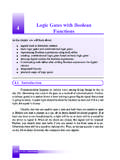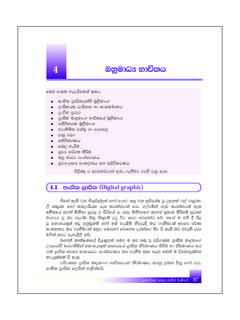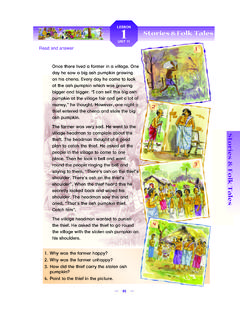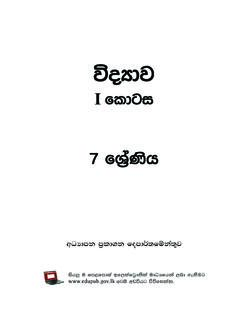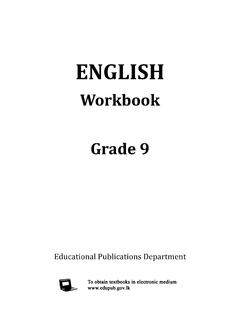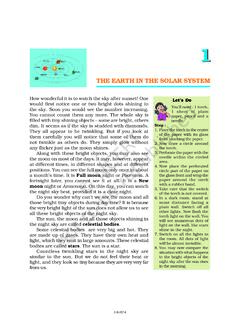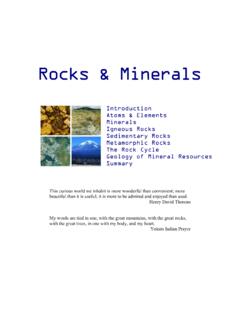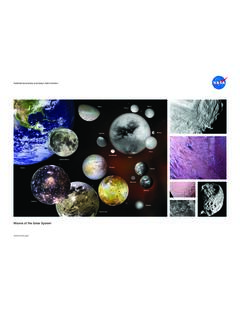Transcription of GEOGRAPHY - edupub.gov.lk
1 GEOGRAPHYG rade 8 Educational Publications Department First Print - 2016 Second Print - 2017 Third Print - 2018 Fourth Print - 2019 All Rights ReservedISBN 978-955-25-0136-4 Published by Educational Publications DepartmentPrinted by Saraswathi Publications, No. 2/60, Circular Road, National Anthem of Sri Lanka Sri Lanka Matha Apa Sri Lanka Namo Namo Namo Namo Matha Sundara siri barinee, surendi athi sobamana Lanka Dhanya dhanaya neka mal palaturu piri jaya bhoomiya ramya Apa hata sepa siri setha sadana jeewanaye matha Piliganu mena apa bhakthi pooja Namo Namo Matha Apa Sri Lanka Namo Namo Namo Namo Matha Oba we apa vidya Obamaya apa sathya Oba we apa shakthi Apa hada thula bhakthi Oba apa aloke Apage anuprane Oba apa jeevana we Apa mukthiya oba we Nava jeevana demine, nithina apa pubudukaran matha Gnana veerya vadawamina regena yanu mana jaya bhoomi kara Eka mavakage daru kela bevina Yamu yamu vee nopama Prema vada sema bheda durerada Namo.
2 Namo Matha Apa Sri Lanka Namo Namo Namo Namo MathaiiiivJ u UP | J | C | Eh Kk J | S v { Au \ P u | J | | C C | u sk A P n h J ] UP vku o zx & Ax a \ . B u \ U P P u .wms fjuq tl ujlf. orefjdatl ksjfiys fjfikdtl mdge;s tl re rh f wm lh ;=< jkdtne ks wms fjuq fidhqre fidhq fhdatl f,i tys jefvkd j;a jk wm fuu ksjfiafid k is h hq;= f ieug u fu;a lreKd .=fKkSfj<S o kSrka Ks uq;= fkd j th u h iem;dlsis l, fkdu rkdwdkkao iurfldakaivvForeword The educational objectives of the contemporary world are becoming more complex along with the economic, social, cultural and technological development. The learning and teaching process too is changing in relation to human experiences, technological differences, research and new , it is required to produce the textbook by including subject related information according to the objectives in the syllabus in order to maintain the teaching process by organizing learning experiences that suit to the learner needs.}
3 The textbook is not merely a learning tool for the learner. It is a blessing that contributes to obtain a higher education along with a development of conduct and attitudes, to develop values and to obtain learning experiences. The government in its realization of the concept of free education has offered you all the textbooks from grades 1-11. I would like to remind you that you should make the maximum use of these textbooks and protect them well. I sincerely hope that this textbook would assist you to obtain the expertise to become a virtuous citizen with a complete personality who would be a valuable asset to the country. I would like to bestow my sincere thanks on the members of the editorial and writer boards as well as on the staff of the Educational Publications Department who have strived to offer this textbook to you.
4 W. M. Jayantha Wickramanayaka,Commissioner General of Educational Publications,Educational Publications Department,Isurupaya, viMonitoring and Supervision - W. M. Jayantha Wickramanayaka Commissioner General of Educational PublicationsDirection - W. A. Nirmala Piyaseeli Commissioner (Development) Educational Publications DepartmentCo-ordination - Anupa Madhupani Weerarathne Assistant Commissioner Educational Publications Department - J. W. Rumesh Jayalath (2019) Assistant Commissioner Educational Publications DepartmentPanel of EditorsProf.
5 N. K. Dhangalla - University of Kelaniya (Emeritus Professor)Prof. S. A. Norbert - University of ColomboR. P. Peiris - Additional Commissioner (Retired) Department of ExaminationsA. R. S. Perera - Assistant Director of Education Bilingual Education Branch Ministry of EducationAnupa Madhupani Weerarathne - Assistant Commissioner Educational Publications DepartmentM. P. Ranjini Dhanawardhana - Director, Department of Social Science National Institute of EducationS. Karunakaran - Lecturer National Institute of EducationPanel of WritersKarunasinghe Somadasa - ISA (English), Zonal Education Office MataraD.
6 M. J. Bandara - Teacher, Kuli/Saranath Kuliyapitiya viiW. A. A. R. Weragoda - Teacher Girls' High School KandyW. K. P. Dhanawardhana - Teacher, St. Peter's College NegomboN. A. Chithralatha - ISA, Zonal Education Office MataraK. K. U. Gunarathne - Teacher G/ Polpagoda , YakkalamullaYalini Karunagaran - Teacher St. Clare's College Colombo 06T. Sharamiladharshini - Teacher K/W/Rajawella Hindu National College DiganaT. Srisureshkumar - ADE, Zonal Education Office MataleS. Ilankovan - Bt/KK/Karuwakerny Vigneswara College Karuwakerny ValachchanaiLanguage EditorM.
7 P. A. M. Weerarathne - Assistant Commissioner Educational Publications DepartmentProof Reader H. Dahanayake - Chief Editor - (Retired) Educational Publications Department Cover Design R. A. Yureka Dilrukshi - IT Unit Educational Publications Department Type Setting (Formatting)Maps, Figures and Page Setting Abisheka Ranasinghege - IT Unit Educational Publications DepartmentR. A. Yureka Dilrukshi - IT Unit Educational Publications DepartmentviiiContentThe Solar SystemUniqueness of the Earth as a habitat of the living beingsThe basic features of 1: 50 000 topographic maps of Sri LankaSouth Asia11172949243ixxFor Free Distribution 11 The Solar SystemThe objective of this unit is to study the composition and functions of the solar Free Distribution 2 Have you carefully observed the sun, the moon and the other celestial bodies in the sky?
8 There is evidence that man had shown an interest in knowing about them since ancient times. At present, man can explore more than what is visible to the naked eye, as scientists have invented modern equipment to observe the has been discovered that there are eight planets, shapeless pieces of planets called asteroids, various celestial bodies such as dwarf planets and natural satellites revolving around the sun. When all these things are taken together, we consider it as a system. This is called the solar system. It is believed that the solar system has been formed 4600 million years ago, by combining dust particles and gases we observe the night sky with our naked eye we can see a multitude of stars. Stars are celestial bodies that emit light and heat. Thus, they are sources of energy.
9 They can be seen shining or twinkling in the night , the other celestial bodies such as planets, natural satellites and asteroids, though they do not emit light, are visible in the night sky as they reflect the sunlight. They are seen with a "monotonous light that does not twinkle".Observe the cloudless, clearly visible night sky and get the above information sun is a star that emits light and Free Distribution 3 Composition of the solar systemThe Sun and the other celestial bodies which are bound by the gravitational force of the Sun belongs to the solar celestial bodies found in the solar system are listed below. The Sun, the main body of the solar system Planets, the largest celestial bodies Smaller planets or dwarf planets Natural satellites of the planets Millions of other rock particles or debris Asteroids Comets MeteoroidsFig.
10 - Solar systemSource - 21/02/2016 VenusEarthMarsAsteroid BeltJupiterSaturnUranusNeptuneCometMakem akePluto ErisCeresSunMercuryFor Free Distribution 4 The SunThe Sun is the main source that provides energy for the existence of life on Earth. The Sun lies at the centre of the solar system. A massive amount of heat is generated at the core of the Sun as a result of fusion and thermonuclear reactions. The temperature of the centre of the Sun is about 15,000,0000C (15 million 0C) while the surface temperature is about important facts about the sun are given below; It holds percent of the total mass of the solar system or the substances that belong to the whole system. Its extent is 109 times of the diameter of the Earth. The diameter is million kilometres. It is a source of energy and it provides energy and heat to all the planets in the solar system.
